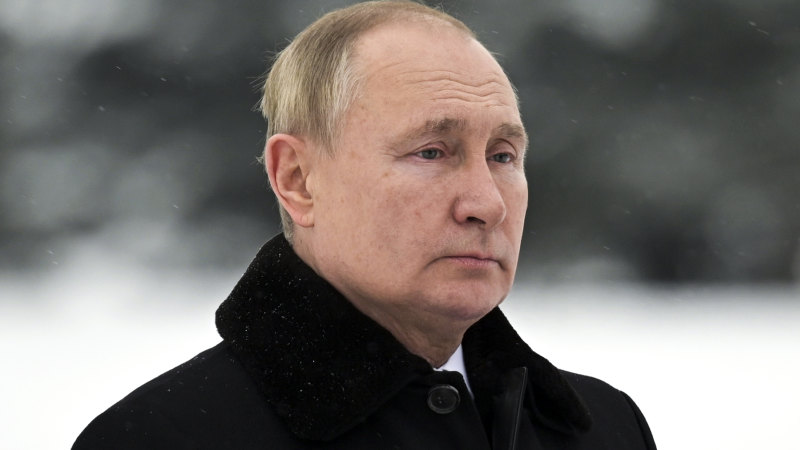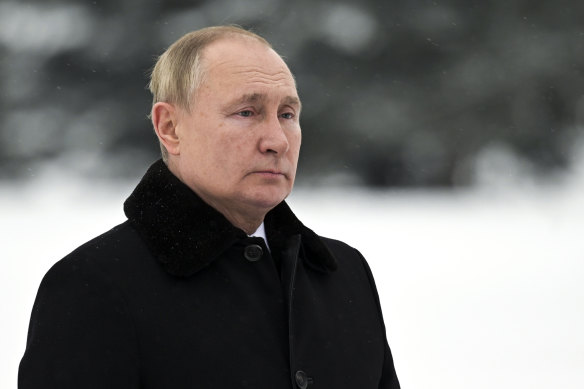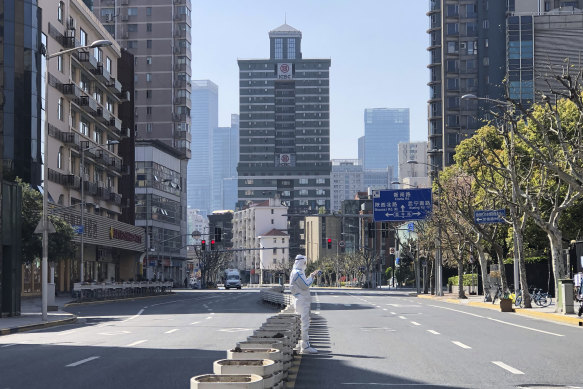Vladimir Putin has drawn up a draft decree prohibiting the sale of Russian oil exports to any country or any entity participating in the G7 oil price cap.
Unless he backs down, the world will soon face a critical shortfall in crude and liquid products, adding an acute oil crisis on top of the gas crisis that we already have. It is widely assumed that the Kremlin will find some way to circumvent the Western stranglehold and redirect 4 per cent of global oil supply from Europe to customers in Asia, happy to take his exports at a stiff discount.
Vladimir Putin is set to play his oil card but it could backfire.Credit:AP
Yet Russia does not have enough tankers of its own and cannot obtain sufficient numbers from the international “shadow fleet”, a motley cast of shell companies on the global margins. The West controls over 90 per cent of the world’s tankers through direct ownership or financing and insurance, above all the P&I (protection and indemnity) club that covers complex spill liability for shipowners – at $US1 billion ($1.5 billion) per ship. Without that you cannot take these floating firebombs through the Bosphorus, the Danish straits, the Suez Canal or enter respectable ports, even in China.
Putin’s decree may be bluster. There are many ways of complying quietly with the $US60 cap while chest-beating at home for nationalist consumption. But he may equally be tempted to play his oil card in a last-ditch effort to destabilise the democracies and pressure the West into accepting a shameful deal in Ukraine.
“He could squeeze the global market by shutting in two to three million barrels a day (b/d) if he chooses to. Russia is a systemically-important exporter of oil,” said Professor Craig Kennedy, an expert on Russian energy at Harvard University. “You can see that they are agonising about it in Moscow: should they risk weaponising oil exports to trigger a price spike, or might it backfire?” he said.
Putin needs oil revenue as the Russian budget dives into a deep deficit. It is becoming harder for the Kremlin to raid the country’s rainy-day reserve funds and there is no domestic bond market to speak of. But his money woes can be overstated. “He has a very strong hedge: if prices jump enough, he can recoup what he loses on volume,” said Christopher Granville from TS Lombard.
Brent crude is currently well-behaved at $US80 as the global economy flirts with recession. The picture will look very different once China fully reopens and global aviation recovers.
Martijn Rats from Morgan Stanley said global jet fuel consumption is still down by 2 million barrels per day (mb/d), and China is 1 million barrels per day below its pre-pandemic level. It is therefore all the more remarkable that global spare capacity in the oil industry has fallen to 1.6 per cent, half its historical level.
Joe Biden has been running down the US strategic petroleum reserve at an effective rate of 0.8 mb/d since March. This helped the Democrats avert a wipeout in Congress last month but it has distorted the global market and disguised the underlying lack of supply. It has also depleted the strategic reserve to its lowest level in forty years.
US shale cannot come to the rescue this time. In previous cycles it grew at 1 mb/d a year, enough to break the OPEC stranglehold on the global market. This year it struggled to reach half that level. The best seams in the Permian and Bakken have been exploited. Morgan Stanley said the “expected ultimate recovery” of wells has dropped this year for the first in the history of modern fracking. Rising capital costs are further eroding the business model of frackers.
Oil demand is set to take off once China reopens its economy.Credit:AP
China’s reopening is likely to have a J-Curve effect on oil as cases spread like wildfire in a ‘naive’ population, leading to self-isolation and jerky stop-go policies. Oil demand could fall this winter before taking off in earnest.
“Road, rail, and air passenger travel in China is still 50-70 per cent below normal levels, which is astonishing. But we don’t think they can risk reopening given the low vaccination rate of the elderly and the lack of ICU beds in hospitals,” said David Fyfe, the IEA’s former oil guru and now chief economist at Argus.
There is a revealing anomaly in the market. The integrated oil and gas sector on the S&P 500 is up by over 60 per cent this year, even though crude is today lower than it was before the invasion of Ukraine.
This extreme divergence suggests that the big funds are looking through the current cyclical downturn, well aware that there are not enough new fields coming on stream to replace declining wells. Capex investment in oil and gas has fallen from $US1.3 trillion ($1.9 trillion) to $US700 billion since 2014. There will be one last structural supply crunch before electrification prevails in the 2030s.
Putin is a predatory opportunist. He began to ratchet up his gas war in the late summer of 2021 only after it was clear that post-COVID recovery was already tightening the gas market. If he is going to withhold oil, he will do so only once market forces are aligned in his favour.
What is clear is that the West has boxed him in with the price cap. His Sovcomflot fleet of 80 active tankers is too small to export crude from Russian ports in the Baltic and the Black Sea. He has acquired another 50 or so but there are limits. Much of the shadow fleet is composed of giant workhorse VLCC tankers that are too big for Russia’s European ports.
“Russia exports 6 mb/d of crude and products by sea, and 80 per cent of this goes out of its western ports. The system was designed to supply Europe. Only 20 per cent of his seaborne exports go through the Pacific,” he said.
This creates a logistics nightmare. Instead of a six-day round trip to Hamburg, his tankers face a 90-day round trip to China, even if they can obtain recognised insurance. That uses more fuel, raises costs by $US12 a barrel, and locks up ships for longer.
“Oil is the only thing that he has left. He has destroyed the rest of the economy.”
The West is banking that Putin will be forced to go along with the G7 price cap, designed to keep oil flowing while eroding his income. It assumes that he will not risk crippling his network of 130,000 oil wells by shutting them down. Only a fifth have strong enough pressure to throttle back output for a sustained period without damaging the field.
Yet Putin has already shown that he is willing to sacrifice his gas industry and shatter relations with the West, all for an anachronistic imperial land-grab. If he hesitates, it is because an oil crisis would risk a rupture with China and India. “It is the last roll of the dice. What’s left if he alienates all buyers of his energy?” said Fyfe from Argus. Or it is because even Putin’s appetite for gambling has limits.
“Oil is the only thing that he has left. He has destroyed the rest of the economy,” says White House energy coordinator Amos Hochstein.
I do not wish to criticise the G7 price cap. It is a justifiable calculus. There is a fair chance that Putin will be ground down by the West’s overwhelming economic and geopolitical power. But he may equally defy the G7 and let rocketing oil prices talk for him.
Telegraph, London
The Business Briefing newsletter delivers major stories, exclusive coverage and expert opinion. Sign up to get it every weekday morning.
Most Viewed in Business
From our partners
Source: Read Full Article


